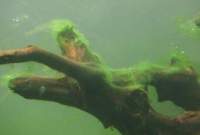You unintentionally find some strange little white creatures roaming on the substrate when you observe your living tank. Perhaps they are scuds that became a popular topic in the aquarium world long ago.
Regardless of their controversy, some people are fascinated by them; on the other hand, they are also considered scuds as a nuisance.
Are you made curious by these guys? If or want to learn more deeply about the pros/cons of keeping them in the aquarium, all fun facts about the scuds will be discussed on this page.
TABLE OF CONTENTS
What Are Scuds?
Scuds (Gammarus Sp.), also known as side-swimmers (sideswimmers), are a freshwater amphipod crustacean species with a shrimp-like body appearance with tiny size.
They belong to the gammaridae family. There are more than 200 described scuds species distributed across all regions worldwide, making it one of the most crustacean genera rich in species.
Any different species of scuds require a specific condition to live, mainly in tolerance level and salinity. For example, Gammarus Pulex is a purely freshwater scuds species, so they can not survive in the marine environment. Another one is G. Locusta; they are estuarine species where these species only live in salinity levels that should be greater than 25 percent. But, it should be kept in your mind if they are one of the robust Malacostraca members.
You need to know that they also have cousins who live on land, including sowbugs, pill bugs, and rolly pollies. It is difficult to remember every species of them and you might often be wrong when determining their species.

Habitat
Scuds can occur in unexpected places such as water streams in the underground water, hot springs, or even saline water.
The freshwater Gammarus species colonized almost all tropical water ecosystems. These organisms can you discover in almost freshwater streams, including ponds, lakes, artificial canals, swamps, streams, and shallow rivers with slow movements.
They usually spend much time inhabiting the spaces between roots, vegetation, or stones. It aimed to protect themselves from predators. Some species also occupy marine environments, even though there are several species that live in the terrestrial territory.
Appearance
Unlike the real shrimp, their body is divided into three groups, segmented, and does not have a carapace but rather a hardened flesh whose texture is thicker compared with other shrimps.
The first part is the cephalothorax; it’s the head section where two pairs of antennae are stuck there. Next is the thorax or body, it consists of seven segments, and each segment has pair of legs. The last is the abdomen which contains six segments where each part of it has appendages to help swim.
Generally, scuds are transparent, but they can turn to another color depending on their diet, where the food enters their body through the digestive tract, which has various green shades.
Besides, they can also present in a brownish tint to camouflage with their environment to prevent predators from hunting them. The females carrying eggs on their bodies frequently look in orange coloration.
How big can Gammarus get? Actually, they can grow in different sizes depending on their species. An adult scud can reach up to 10-20 mm in length in the aquarium.
But the majority size usually is just about 3-8 mm, with the males being slightly huge than females. While their color can be brown reddish-black, grey, yellow, white, tan, etc.
Diet And Feeding
Scuds accept various diets such as animal or plant materials including algae. So as an omnivore, they can survive well in the wild.
The freshwater Gammarus types are given a significant effect on the environments they live. When the leaves are fallen into the stream’s water, they consume it and turn the leaf litter into delicate organic matter. This activity can increase the decomposition rate of leaf litter.
Temperature And Water Parameters
From the information on the site, the freshwater amphipods are known pretty hardy and can live through the winter season as long as indoor temperatures do not fall below freezing. They prefer the quite warmer environments and would not reproduce except if the temperature reaches around 25 degrees Celcius (75 °F).
Life Cycle
Newborn scuds only have a 1 mm body length, while their physical appearance resembles the mature ones. After that, they should pass through 9 different evolution cycles, molting around once in 5 days.
Their lifespan regularly is about one year and only a few specimens that can survive for two years or more.
For some similar species, a colder living environment can support increasing lifespan, but as a replacement slow down their growth rate. At the same time, warmer conditions will encourage growth rapidly and sacrifice lifespan.
Reproduction
The different species have different periods of reproduction chapters. For example, Hyalella Azteca is one of the most popular scuds for freshwater aquariums used; they known can reproduce about once a month under optimal environmental conditions, with a single big female can generate around 60 eggs. But, mostly, they only carry up to 20 – 30 eggs.
Gammarus fries mostly reach an adult age in about 45 days. They can reproduce all year round under warmer temperatures, whereas in icy places, the mating season only happens when the summer periods.
Mating start when females are molting, they have an intermoult period of 11 days (10-13 days), and males are about 20 days (8-43 days). Males attach themselves to the above female bodies using their legs before molting. Then, females bring out the males for a couple of days on their back before they molt. Males help shed out the old exoskeleton throughout the molting process.
Once fertilization is complete, males leave the females soon. The incubation period commonly takes about 11 days at 20-degree Celcius (68 degrees Fahrenheit). Change in temperature is vital, it can influence the metabolic system of Gammarus.

Are Scuds In Harmful For Fish And Snails?
They are safe for fish. Instead, fish look happier when seeing the scuds movement; it may trigger their hunting instinct. So, many fish hobbyists make them another food source for their pets.
But they may bring other problems for fish babies. As documented in some scientific studies, they are opportunistic, can eat or hurt the eggs, and even damage small fries.
In other cases, scuds are not really friendly with snails. In particular conditions, they can attack or try to annoy them by continuously grooming or picking up their mucus. As the omnivorous, they may also eat the snail eggs.
This situation might not happen for snail varieties with a trap door; this feature promotes protection to their body inside the shell from any attempt that bothers them.
Are Scuds Harm For Plants?
However, many people think that scuds are suitable for planted tanks, but they are still not safe for the plants.
Some aquarists suggested to minimize their appetite, adding vegetables such as zucchini, lettuces or cucumbers is the solution. Unfortunately, it is not still completely accurate.
According to the reports from the other sites and multiple hobbyists’ experiences, the scuds begin to bite the plants’ parts little by little, even though there was another meal in the aquarium. They prefer to eat the delicate parts of leaves and untouched stems. The softer they are, the higher the possibility that Gammarus will snack on them one day.
Some aquatic plant types are often targeted, like java moss, hornwort, dwarf sagittaria, amazon sword, anacharis, rotala rotundifolia, java fern, etc.
From the list above, you can see that even the amazon sword with a hard texture can still be pulverized when they feel hungry.
Another problem is that they might go under the substrate and start eating the roots, weakening the plants and starting to decay.
It seems floating and fast-growing plant types can have a great chance to live well in a freshwater aquarium with scuds there. Salvinia natans, Azolla cristata, and duckweed are the samples; they can grow faster and more steadily than Gammarus could eat.
Is Scud Bad For Shrimp Tank?
In fact, yes, they are dangerous and do not be kept in the same aquarium, so if you want to achieve a successful goal in breeding shrimp.
We will explain some reasons from the statements before:
- Food Competition: Gammarus are very voracious scavengers; they may outcompete shrimp easily remember both of them share the same resources, including food (algae, biofilm, detritus, and more), living places, and substantial ecological overlap. This makes competition between them often happen, suffering the shrimps.
Furthermore, please remind about baby shrimps; they spend several days hiding in one place with plenty of plants and do not be brave to swim into open areas to get some food. Instead, shrimp fries are just waiting for floating particles, biofilm, or algae to approach their nest.
Young and adult scuds will explore the tank entirely to discover anything they can eat without concern for their tankmates. So, if your shrimplet numbers are lessened, it indicates outcompeting. - Tolerance: As we know, they are one of the most successful creatures that can survive well in various freshwater ecosystems. Several species can live under higher temperatures, lower O2 levels, salinity levels, PH fluctuations, even in areas out of the water for several days.
- Potential Aggression: Although, we do not get more proof about scuds striking or eating young or adult shrimp in an aquarium. But, it does not mean that keep away the possibility, primarily when shrimps are weak and vulnerable during the molting cycle.
- Breeding Competition: Scuds have a shorter reproduction cycle and are faster than shrimp. Their populations will rise rapidly, consuming more foods and only leaving a slight food source for shrimp.
How Can Scuds Introduce Into Your Fish Or Shrimp Aquarium?
Sometimes Gammarus enters the aquarium accidentally or the keeper’s mistakes. The typical cause is they usually often hitchhike on new aquatic plants added. The baby scuds are clever to hide within the plants, mainly moss species which are their favorite snacks.
You probably do not notice because their size is too tiny to see, then they begin to burry up into the substrate bottom. After several weeks and their number grows, the colonies start to present in your tank.
Another way to invite Gammarus to invade your aquarium is from the water in the fish bag or sticking on fish bodies or snail shells that you recently bought from the sellers.
How To Get Rid Of Scuds In Your Aquarium?
Removing scuds colonies until zero number is almost impossible unless your tank base is empty. So, think again before you put them into your freshwater tank or shrimp aquarium. Below are some techniques that you can try in wiping the Gammarus effort:

Remove Manually
This method may need much time and effort, do not expect more to clean all scuds. Some creatures such as shrimps, fish, or snails are able to trap into your net, be careful. Here are the steps should you follow:
- Locate a net on the tank floor
- Placing a small piece of blanched lettuce, carrot, cucumber, zucchini, cabbage, or green beans in the net. Then, left it for a few hours.
- Afterward, you will notice the scuds gathered entire the food.
- Let’s pick up the net out from the tank with the food inside.
- Collect scuds or throw them to your fish or other pets.
- Clean the net and repeat the process until you feel enough.
Scuds Trap Method
The planaria traps (check on Amazon) typically work to capture them, although it requires much time. This stuff runs effectively if the scuds colonies are not too much yet. How to use it? It is straightforward; add a tiny bit of shrimp or fish food at the bulb end of the vial. Next, positioning it in the dark areas that scuds preferred.
Keeping Some Scuds Fish Hunter
Many tropical fish types prey on most Gammarus families as one of the primary diet resources in the wild nature. They would be happier if you offered scuds in aquarium environments too.
Most loach types (such as zebra botia, clown loach, and macrcantha botia), some cichlids species (like oscar, red devils, and julidochromis), pea puffers, betta, tetras, molly, etc. usually will hunt like a flash of lightning when seeing them at first the sight.
Unluckily, this technique has some downside that might offer significant effects. In a specific case, you should introduce new fish into your aquarium that you do not want to be entered in there. For example, even though betta or pea puffers are small, they are still not secure for shrimptank.
A bigger tank is susceptible; the scud fish eaters probably can not fully eradicate them. Wherever it can be true, you must pay with a lot of time. Based on some reports that we found, even loaches, livebearers, cherry barb, and corydoras could not eliminate them in 160 liters (40 gallons) tank size.
Moreover, only in open spaces can they control the scuds number. While most colonies settled in many hiding areas like crowded plants under the rocks, sneaking out between the driftwood, and even occupying filter media.
CO2 Nuke (Carbonated Water)
Another trick to getting rid of scuds is using soda water, sparkling mineral water, or seltzer water without impacting the plants. This way could bump the PH level high and suffocate them. Follow the steps below:
- Reduce the tank water as much as you can. This treatment will be more effective when the water is less.
- Fill up the carbonated water into your tank. Make sure to cover completely the substrate with this liquid where the Gammarus used to hide.
The disadvantages of this trick are that:
- Consuming much time
- It can kill other creatures like shrimp, snails, and even fish. So, ensure to move all your pet to a separate tank.
- You may find some scuds still alive in your aquarium.
Copper Treatment
For most fish keepers do not need to explain more about copper which is very dangerous in shrimp and fish keeping. Especially the crustaceans genera including crabs, crayfish, and dwarf shrimp are very sensitive to this substance. Below is the series of steps:
- Purchase a copper test kit, this tool can help you.
- Drain out the water level as much as you can. It can gain a successful chance to remove them.
- Supplement the water with copper sulfate minimally around 1.5 to 2 mg/l or 5 until 2 ppm.
- Abandon your tank in this condition for 3 days.
- Once the treatment process is over, fill up the aquarium and perform a huge water change to drop off the copper concentration.
- After that, load the tank with water again, then check the copper content level.
- Reassure the copper should be gone or at least stay at a maximum level that tolerates by the pets before you add them back. If you sense the concentration is still high enough, do a water change again.
Although this method sounds powerful, indeed it also may cause a negative side. A number of copper particles should remain in the aquarium and it can still damage dwarf shrimps if you choose to them back.
AlgaeFix Overdose Treatment
Some people say the AlgaeFix overdosing can work against them. This solution known has a specific note, do not use AlgaeFix with crustaceans such as shrimps, crabs, freshwater lobsters, and shrimps. Well, it is what we want. But, do not make an opinion that this mixture overdosing is safe for snails and fish; take them out.
Seachem Excel Overdose Treatment
Some aquarium keepers recommended injecting seachem flourish excel in heavy doses (about 10-15 times or more).
This solution has an active component called glutaraldehyde. It is a biocide that can cause a chemical burn to material tissues. For your information, this biocide is generally used in the medical sector as sterilizing for some instruments.
Be aware of this treatment; this can wipe out all tank populations such as shrimps, fish, snails, and some plants (like moss, vallisneria, subwassertang, etc.). So, move them all to a separate tank previously.
Remember, they are mighty and intelligent creatures. A few of them may escape by digging into the substrate. Stir it continuously to remove them perfectly.
Hydrogen Peroxide Treatment
Many people trust if this method really works to combat scuds invasion. Most of them flocked to go with this option. Below are the steps:
- Evacuate all tank populations, including plants, fish, shrimps, and snails, into a quarantine aquarium. Left them in there for a couple of days while waiting for the treatment process.
- Detailly check that no one of scuds transferred into the quarantine aquarium.
- This time to medication, clean and rub your aquarium, equipment, driftwood, stone, and other decorations using hydrogen peroxide (check on amazon for detail).
- Lay it all under the sunlight to dry for several days.
- Replace the filter media or sponge, do not think to reuse it again.
In theory, the substrate from an infected tank should not be used again. But if you insist on still reusing it, boil the substrate for a while until you sense confidence if the scuds are dead. You can also pour boiling water onto the substrate straight from a boiler, then stir it constantly to annihilate everything in it.
How To Avoid Scuds Infestation In My Aquarium
The best trick to keep your tank away from them is to prevent the trouble before it comes into.
An important thing you should do is always quarantine everything before you add it to your aquarium. Treat anything including fish, snails, shrimps, plants, crabs, crayfish, driftwoods, decorations, and more from another source as stuff as infected. That is all probably have been in contact with some biological object which worried contain scuds or their eggs.
Practicing an extended quarantine is very useful; if some objects contain these pests, they will be presents themselves sooner or later. Then, you can take action to deal with them.
Some people advise to do not to overfeed; it is another way to head off the Gammarus. Although this is a bad practice, in fact, it does not work to fight with them. Despite cutting off the food amount, these little pests can always find some meal inside the tank.
Based on some experiments, some scuds specimens known can still be alive without food for around ten days inside the aquarium.
How To Raise And Breeding Scuds In Aquarium
This is a bonus chapter and may be helpful for anyone that wants to try to culture them or breeders looking for other food resources with rich nutrients for their animals that cultivate, such as dwarf frogs or fish.
As we know, they are hardy creatures that can live anywhere in various situations. Therefore, raising and breeding them at home should not cost too much. before reading this guide, it would be better to check the scud products on Amazon.
- We say there is no minimum requirement for the tank size. But to help you easier to manage, using a 2.5 – 5 gallons tank is advised.
- Gammarus are very small animals similar to dwarf shrimp which generate the smallest feces. Well, you do not need a high-pressure filtration system. A sponge filter with big pores is a compatible gear in scuds cultivation. It is low priced and easy to clean and maintain. In addition, this filter type also provides multiple perforated surfaces which can use by scuds to graze and live in.
- Please do not give them too much aeration and current. A little bit of bubbles every one or two seconds is sufficient.
- There is no rule for substrate type used. Select what kind of types you want; as an idea, coarse gravel serves more hiding points, making the scuds happier.
- Additional driftwood or other hardscapes has more value, it can provide food for a long time and offer a settlement.
- Keeping some aquatic plants is necessary. They can become a hiding place or diet source when they are hungry. However, never think about putting plants that you want they are safe.
- Installing an aquarium LED is unimportant. But, if you keep some plants or algae to keep growing, adapt the lighting intensity and duration as much as needed.
- Water parameters are given a pretty significant impact on their development progress. The temperature should be around 20-24 degrees Celcius (68 – 74 °F), a pH level between 7.0 – 8.0, and the water hardness about GH > 10. This is the best condition for them to reach growth optimally.
- Calcium compound is promoted in their shell establishment. Drop some cuttlefish bones or crushed corals into a breeding tank to boost this progress.
- Feed them a few times weekly. Never lay too much food; a small portion is more than enough. Overfeeding can pollute the water. They consume almost all food types, including shrimp or fish pellets, flakes, algae wafers, blanched vegetables, etc.
- Always monitor the water parameter using a test kit and do a periodic water change of about 10-20 % to keep it in optimal condition. Assure only use dechlorinated water to secure your scuds colonies. Note: scuds can inhabit well inside green water.







